I play the keyboards.
Images of Rock n Roll Keyboard players circa the mid 1970s.
 Alright! So earlier this week I described the successful completion of the RCA OP-6/BA-2 microphone preamp. Check out this previous post for all the construction and technical details. The short story is: the RCA OP-6 is one of the most fetishized vintage mic preamps out there; I have always wanted to try one out; the easiest/cheapest way for me to do this was to build one (or at least as close as I could get). The problem is that the input stage requires a special attenuator device, exact values unknown; therefore I had to substitute an input stage from another device. I chose the input stage from the RCA BA-2, as I have built many of these and they always work great. The result: a hybrid of the OP-6 and the BA-2.
Alright! So earlier this week I described the successful completion of the RCA OP-6/BA-2 microphone preamp. Check out this previous post for all the construction and technical details. The short story is: the RCA OP-6 is one of the most fetishized vintage mic preamps out there; I have always wanted to try one out; the easiest/cheapest way for me to do this was to build one (or at least as close as I could get). The problem is that the input stage requires a special attenuator device, exact values unknown; therefore I had to substitute an input stage from another device. I chose the input stage from the RCA BA-2, as I have built many of these and they always work great. The result: a hybrid of the OP-6 and the BA-2.
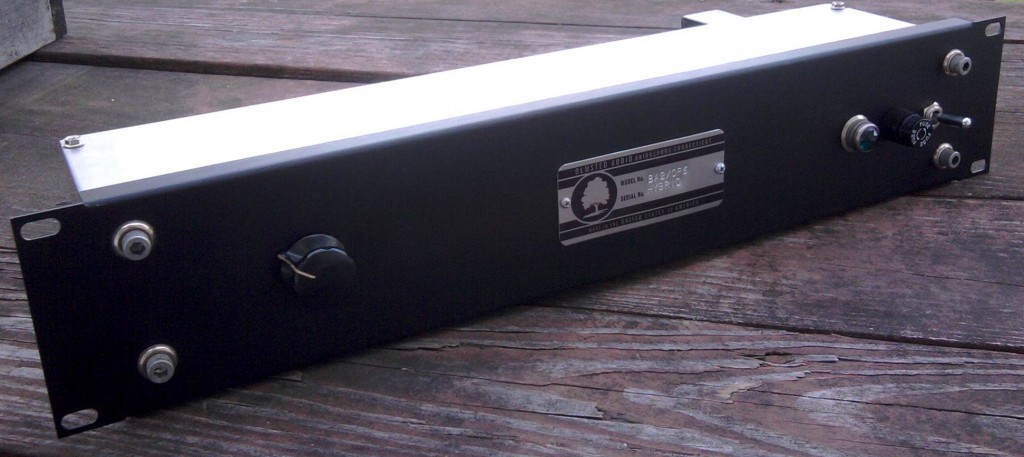 OK so there it is. Anyway, the very helpful+generous TW came by to help me out on this one. I wanted to try the OP-6/BA-2 Hybrid (hf. OBH) on a couple of different sources with a couple different types of mics. We a/b’d the OBH with an API 512. I use the API 512 as a benchmark for mic-pre shootouts because it’s a high-quality unit that many people own and use regularly. What you are about to hear are identical mics tracked through the two different preamps, direct to Pro Tools via a Lynx Aurora. Levels were matched. No other processing, level adjustment, or manipulation was done. You are hearing exactly what came out of the preamps. To appreciate the differences between the units, you will need to listen to these files on good headphones or a full-range speaker system. If you listen on a system with a subwoofer (we used the Blue Sky system at Gold Cost Recorders), you will hear some dramatic differences.
OK so there it is. Anyway, the very helpful+generous TW came by to help me out on this one. I wanted to try the OP-6/BA-2 Hybrid (hf. OBH) on a couple of different sources with a couple different types of mics. We a/b’d the OBH with an API 512. I use the API 512 as a benchmark for mic-pre shootouts because it’s a high-quality unit that many people own and use regularly. What you are about to hear are identical mics tracked through the two different preamps, direct to Pro Tools via a Lynx Aurora. Levels were matched. No other processing, level adjustment, or manipulation was done. You are hearing exactly what came out of the preamps. To appreciate the differences between the units, you will need to listen to these files on good headphones or a full-range speaker system. If you listen on a system with a subwoofer (we used the Blue Sky system at Gold Cost Recorders), you will hear some dramatic differences.
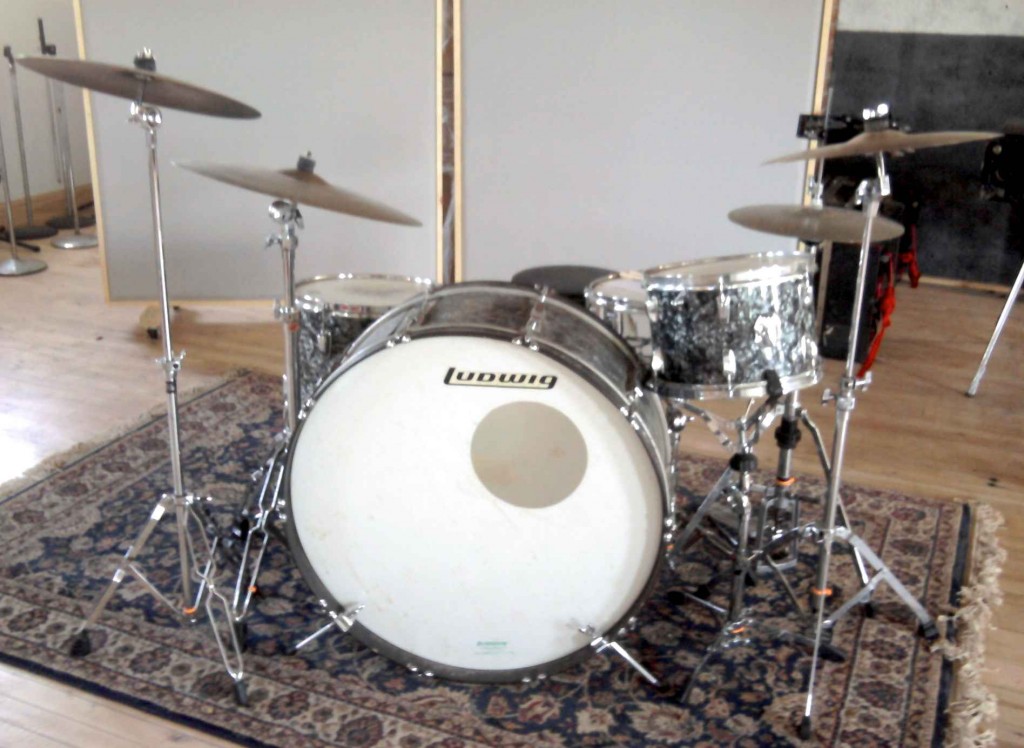 OK. So first up: let’s listen to the drum kit above. These are vintage ludwig drums, 30″ kick, 12″ and 14″ toms, 14×5 wood snare. Cymbals are fairly dark old Zildjans. You are hearing two identical Shure SM-81s placed right next to each other, approx 8 feet in front of the kit, pointed directly at the kit. The 10db pads on the SM81s are engaged. The SM81 is not the prettiest sounding mic, but they have a very flat frequency response.
OK. So first up: let’s listen to the drum kit above. These are vintage ludwig drums, 30″ kick, 12″ and 14″ toms, 14×5 wood snare. Cymbals are fairly dark old Zildjans. You are hearing two identical Shure SM-81s placed right next to each other, approx 8 feet in front of the kit, pointed directly at the kit. The 10db pads on the SM81s are engaged. The SM81 is not the prettiest sounding mic, but they have a very flat frequency response.
First: here’s the API 512:
LISTEN: Drums_API
…and here’s the OBH:
LISTEN: Drums_RCA_hybrid
Our impressions were as follows: the OBH has more low end extension. On the Blue Sky system, the kick drum in the OBH signal moved the room in a way that the API simply could not. The API seemed to move the kit a little closer to the plane of the speakers, but at the same time the top end was not as in-focus. There is a definite low-midrange boost going on with the API. I can say this with relative confidence because I measured the frequency response of the OBH and it is totally flat from 15Hz – 10K, with only a very slight raise above 10K. In terms of operation: the API gain control was at 3 o’clock; the OBH was at 9 o’clock. WOW that is a lot of gain.
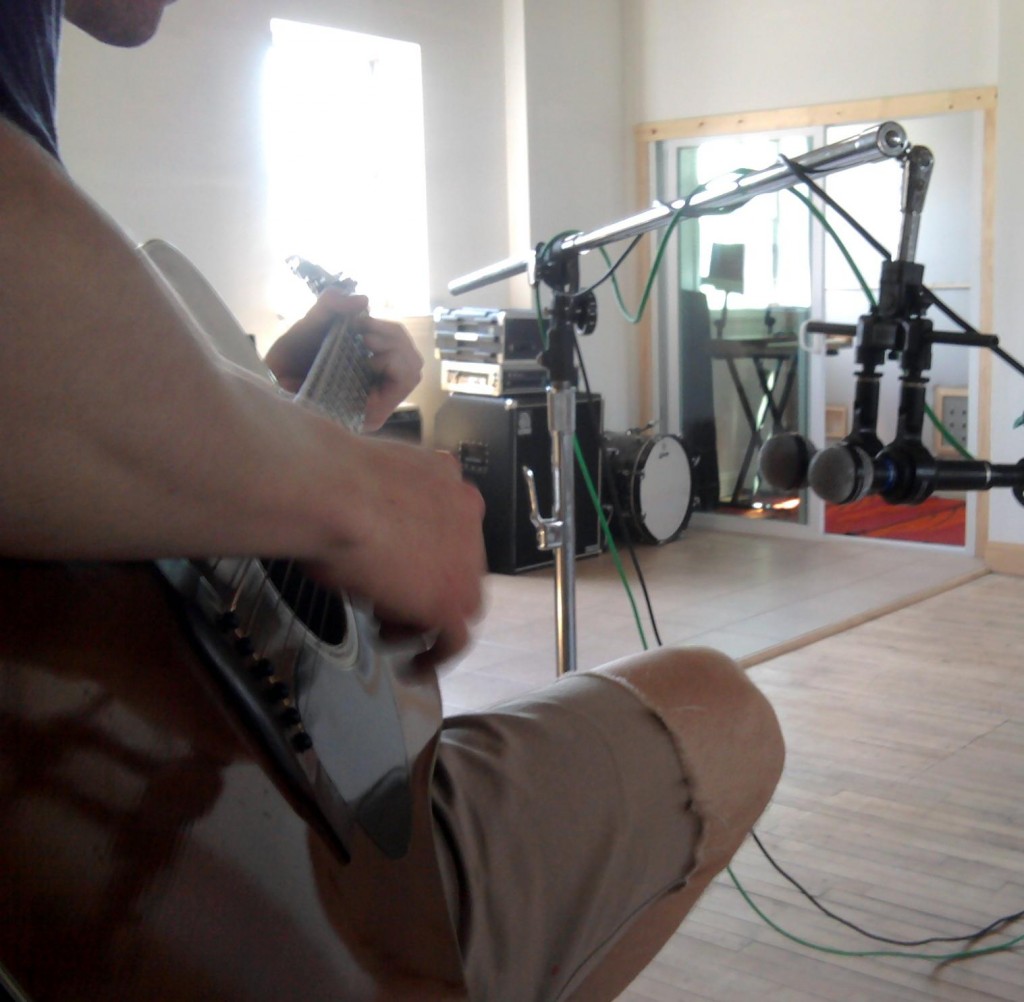 Next, let’s listen to some acoustic guitar. TW played an old Martin D-19 (same as a D-18) that i mic’d with a well-matched old pair of Beyer M260s ribbon mics. The M260 has a built-in gentle roll off that starts at around 200hz
Next, let’s listen to some acoustic guitar. TW played an old Martin D-19 (same as a D-18) that i mic’d with a well-matched old pair of Beyer M260s ribbon mics. The M260 has a built-in gentle roll off that starts at around 200hz
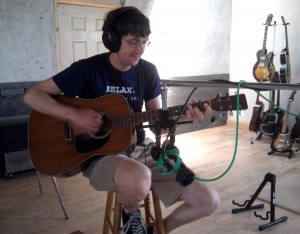 Alright so take a listen. First, the API 512:
Alright so take a listen. First, the API 512:
LISTEN: AcGtr_API
…and now the OBH:
LISTEN: AcGtr_RCA_Hybrid
Our impressions were that the OBH had more low bass but less low mids; it had a more ‘mellow’ feeling. The OBH also had better high-end extension. This also resulted in slightly more HVAC (air conditioning) room noise in the OBH. Although I like the sound of the OBH again here, it is less of a clear-cut choice. The mid-boost that API seems to deliver is very welcome in this particular setup.
In summary: TW put it this way: ‘(the OBH) is like a pair of gentle shelves (shelving EQs) on the very highs a lows.’ I think this is very accurate. The OBH seems to give what I think of as an English sound: that sort of larger-than-life, hyper-real sound that UK records have always aspired to. I highly encourage your DIY’ers out there to give this project a shot; you will find it to be a very useful tool.
Thanks again to TW for his help with this listening test; T’s band THE STEPKIDS is just back from LA where they did a direct-to-vinyl (!) live set in front of a studio audience (!!!) at Capsule Mastering Labs. Check out the details of this very cool endeavor here and here.
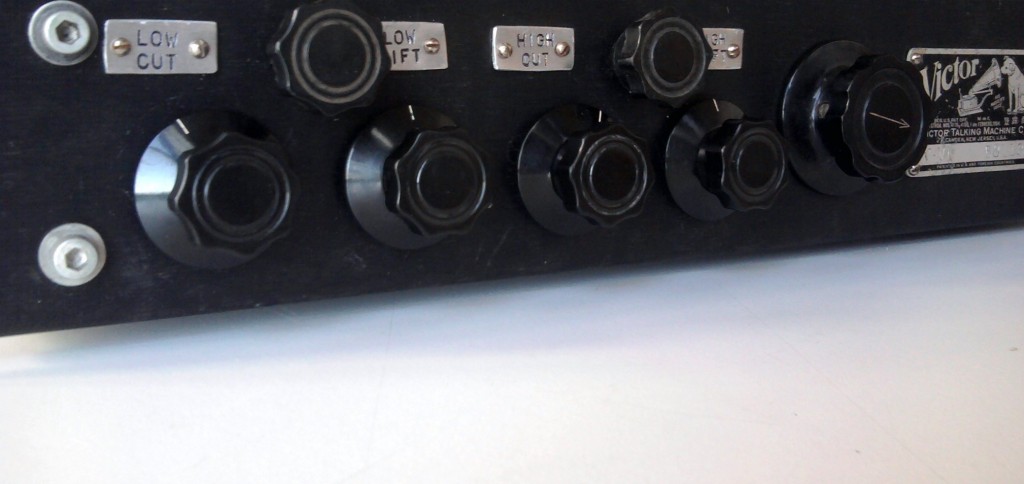 The vacuum-tube powered program EQ that I described in this previous post is nearly complete. This thing has sat on the shelf for a while, as it was a little daunting dealing with all those parts inside a 17x4x3 chassis. So far so good, though… very excited to fire this thing up in a session.
The vacuum-tube powered program EQ that I described in this previous post is nearly complete. This thing has sat on the shelf for a while, as it was a little daunting dealing with all those parts inside a 17x4x3 chassis. So far so good, though… very excited to fire this thing up in a session.
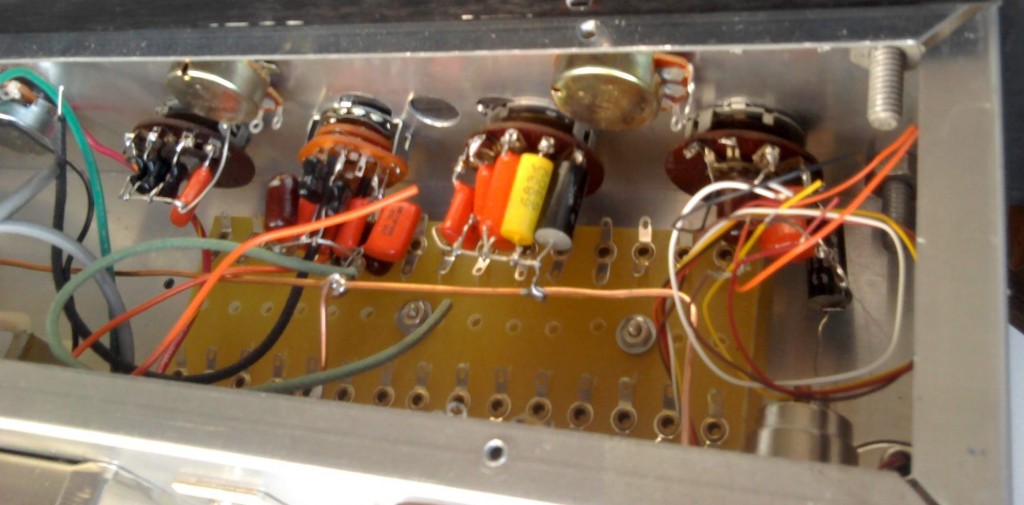 Here you can see the frequency-selection switches all wired up. The switches are 5-way, single-deck switches with the exception of the hi cut, which requires a 2-gang switch. The EQ has separate boost and cut sections, like a pultec, with 5 selectable frequencies for each. The amount of boost shelving is variable via a pot, while the attenuation controls are fixed cut. It would be easy to make the cut controls variable as well, but as you can see I am a little short on space! I suppose I should use a 3U enclosure the next time. Alright stay tuned…
Here you can see the frequency-selection switches all wired up. The switches are 5-way, single-deck switches with the exception of the hi cut, which requires a 2-gang switch. The EQ has separate boost and cut sections, like a pultec, with 5 selectable frequencies for each. The amount of boost shelving is variable via a pot, while the attenuation controls are fixed cut. It would be easy to make the cut controls variable as well, but as you can see I am a little short on space! I suppose I should use a 3U enclosure the next time. Alright stay tuned…
UPDATE: This piece was finished, and it sold to a prominent producer/engineer before I had the chance to record a thorough demo of it. It worked out very well. The circuit performed as-advertised, and the only problem was that it had a little too much gain – enough to use a mic preamp in the majority of situations. Since it has sold it’s been used on several major records; when these albums are released I will provide links to some of the sounds tracked through it.
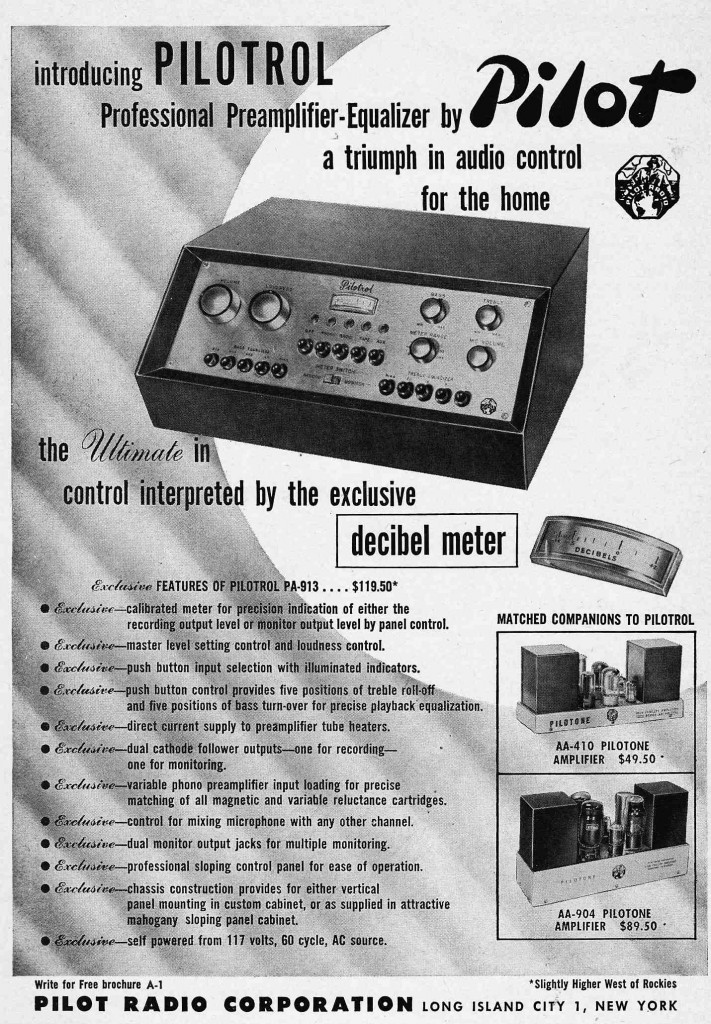 Pilot was one of the classic NYC Golden-Age Hi-Fi makers (see here for earlier coverage on PS dot com). Although the Pilotuner mono FM tuner series was their most iconic product, the Pilotrol was their flagship offering.
Pilot was one of the classic NYC Golden-Age Hi-Fi makers (see here for earlier coverage on PS dot com). Although the Pilotuner mono FM tuner series was their most iconic product, the Pilotrol was their flagship offering.
The Pilotrol seems like an attempt to satisfy the most compulsive hi-fi fans; it really seems like they tried to cram as many lights, buttons, features, and knobs in there as possible. What with the excess of buttons, slant-front cabinet, and VU meter, Pilot seems to have been trying to turn the simple act of using your audio system into an experience; I see shades of ‘Mission Control,’ ‘The Cockpit,’ and maybe police radio as well in the design. Anyhow, it’s too bad this is a mono unit; otherwise I’d be looking for one…
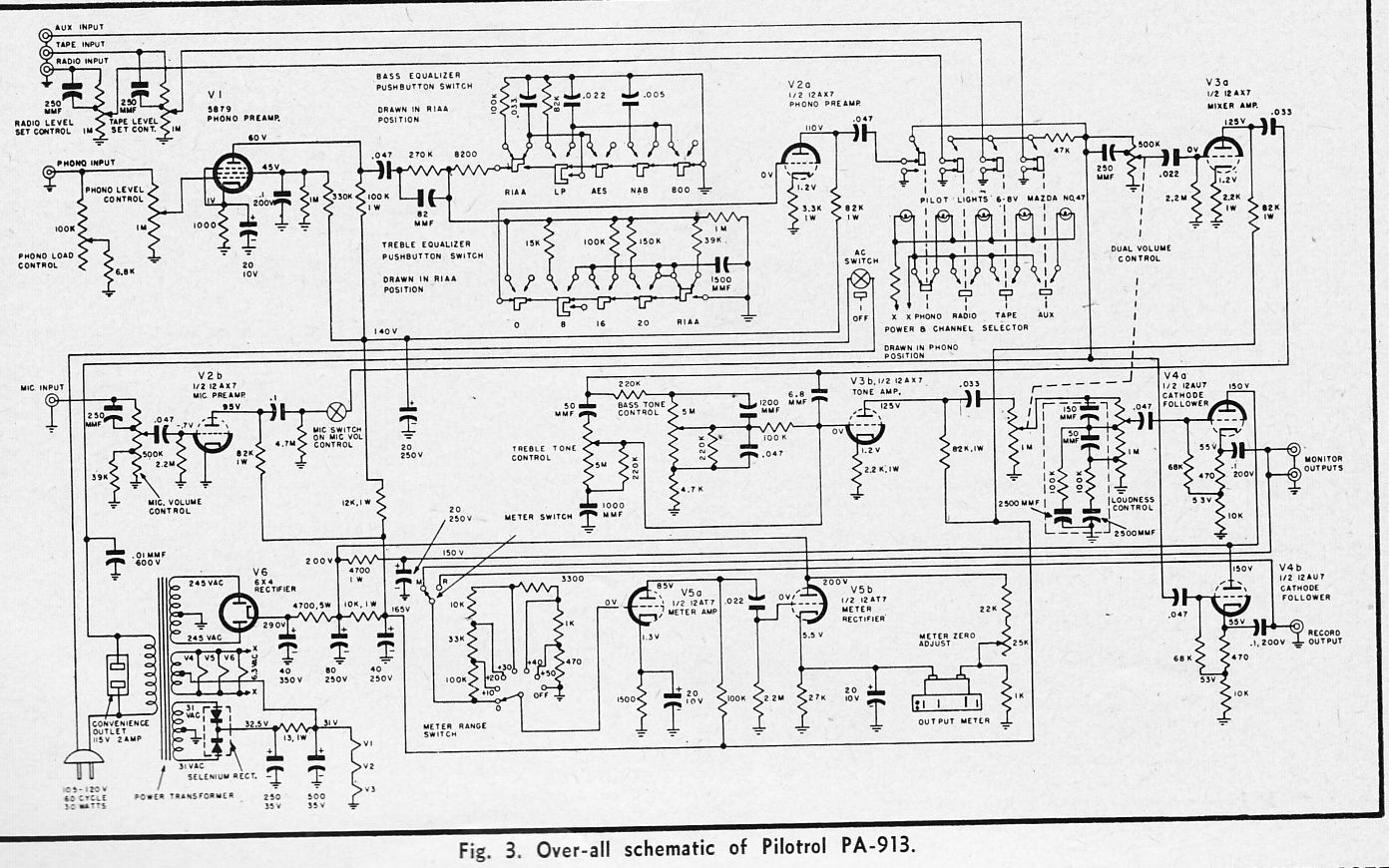 Here’s the schematic. Nice pentode phono input. Anyhow, we can see echos of the Pilotrol and its feature-laden ilk in much hi-fi gear of the 70s – consider a typical high-end receiver of that era. Modern equivalents offer even more features, but nowadays the buttons and lights have been replaced with menus and screens. In opposition to this thread, we have the minimalist streak best exemplified by Apple and its associates. Which operating principle do you prefer? Do you want the equipment to be in the background or the foreground of your audio-listening experience? Exactly what is ‘the experience’ for you? Hearing the sounds? Or is the operation of the apparatus essential to your enjoyment? At what point will technology become so advanced and so pervasive that ‘controls’ themselves can only been seen as quaint and nostalgic? Are we there yet?
Here’s the schematic. Nice pentode phono input. Anyhow, we can see echos of the Pilotrol and its feature-laden ilk in much hi-fi gear of the 70s – consider a typical high-end receiver of that era. Modern equivalents offer even more features, but nowadays the buttons and lights have been replaced with menus and screens. In opposition to this thread, we have the minimalist streak best exemplified by Apple and its associates. Which operating principle do you prefer? Do you want the equipment to be in the background or the foreground of your audio-listening experience? Exactly what is ‘the experience’ for you? Hearing the sounds? Or is the operation of the apparatus essential to your enjoyment? At what point will technology become so advanced and so pervasive that ‘controls’ themselves can only been seen as quaint and nostalgic? Are we there yet?
See this link for some more thoughts on the function of ‘control’ in consumer audio equipment.